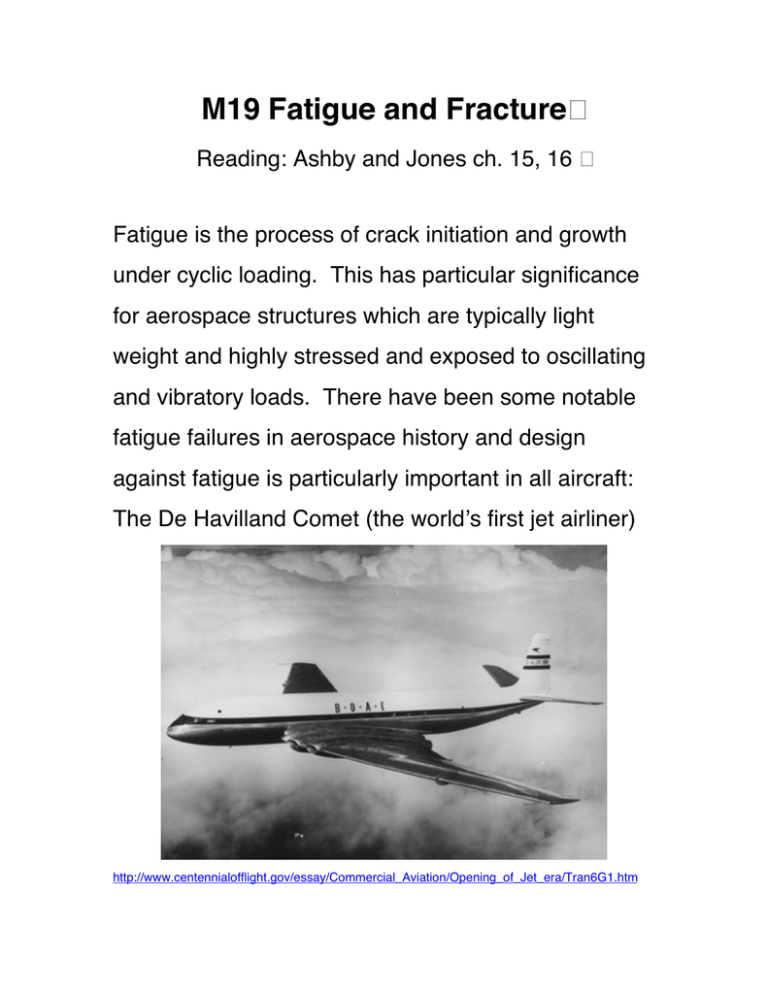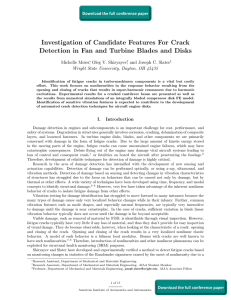M19 Fatigue and Fracture �
advertisement

M19 Fatigue and Fracture� Reading: Ashby and Jones ch. 15, 16 � Fatigue is the process of crack initiation and growth under cyclic loading. This has particular significance for aerospace structures which are typically light weight and highly stressed and exposed to oscillating and vibratory loads. There have been some notable fatigue failures in aerospace history and design against fatigue is particularly important in all aircraft: The De Havilland Comet (the world’s first jet airliner) http://www.centennialofflight.gov/essay/Commercial_Aviation/Opening_of_Jet_era/Tran6G1.htm Basic mechanisms: � Fatigue crack initiation: stress cycling drives dislocations on slip planes. Leads to dislocation “pile up” and formation of “persistent slip bands” Y SLH 1 PSB Matrix ys 2 A SRH 1 2 ye B A X Matrix Interface dislocation C B' B' A' A' S S b A A B B B D A Descriptions of the critical annihilation distance for screw and edge dislocations. B Mechanism of extrusion formation by combined glide and dislocation annihilation. C Irreversible slip in the PSB creating effective interfacial dislocations which put the slip band in a state of compression. D The combined effects of applied stresses and internal stresses. Bigger arrows indicate repulsive forces on interfacial dislocations and smaller arrows denote forces .. caused by the applied load. (After Essmann, Gosele & Mughrabi, 1981.) Image adapted from: Suresh, S. Fatigue of Materials. Cambridge University Press, 1998. Persistent slip bands initiate cracks, initially in shear and then grow under tensile load. σ Slip planes Stage 1 cracks Stage 2 crack σ How cracks form in low-cycle fatigue. Image adapted from: Ashby, M. F., and D. R. H. Jones. Engineering Materials 1. Pergamon Press, 1980. Cracks continue to grow by local plasticity at crack tip:� Kmax New surface π δ/2 δ ry ary πδ 4 δ How fatigue cracks grow. Image adapted from: Ashby, M. F., and D. R. H. Jones. Engineering Materials 1. Pergamon Press, 1980. Initiation of cracks due to local plasticity, often caused by stress concentrations, local surface roughness, wear damage at contacts etc. Lower yield stress materials more prone to fatigue at a given stress level. Also, welded joints can be sources of residual stresses and lower yield stress – tend to avoid welds in aerospace structures. Models for Fatigue Several empirical models exist for fatigue life and fatigue crack growth. In cases where lifetime is dominated by fatigue crack initiation, common to use stress-life (S-N) curves and empirical fits to the data: e.g. DsN af = C Where (Basquin’s “Law”) � Ds = stress range, N f = number of cycles � to failure, a, C are empirically determined constants. � Log σ σ TS x Low cycle fatigue x x x σγ High cycle fatigue x x x Plastic deformation of bulk of specimen x x x x x 1/4 102 = 104 106 x Elastic deformation of bulk of specimen Basquin's law Log Nf Initiation-controlled high-cycle fatigue - basquin's law. Image adapted from: Ashby, M. F., and D. R. H. Jones. Engineering Materials 1. Pergamon Press, 1980. Also need to be able to assess affects of spectrum loading (varying amplitude cycling) and effects of maximum stress level. Other empirical models used if large scale plasticity � occurs (generally does not in aerospace – see A&J) � In cases where crack growth occupies a significant fraction of the lifetime we can use models for crack growth. Usually observed that crack growth rate (da/dN) depends on applied stress intensity factor, ( ) DK = Ds pa . e.g. da = ADK m dN (Paris “Law”)� log da dN ( ( Fast fracture Steady state Threshold da = A Km dN log K Kmax = Kc Fatigue crack-growth rates for pre-cracked material. Image adapted from: Ashby, M. F., and D. R. H. Jones. Engineering Materials 1. Pergamon Press, 1980. Can use such models to estimate life: Nf af N f = Ú dN = Ú 0 da m ADK a0 where 2� ˆ Ê 1 Kc af = Á ˜ p Ë s max ¯ Crack growth rate will accelerate over life of part. Majority of time spent near initial length. Cracks generally only grow in tension. σ K = σ πa a Kmax = σ max π a Kmin = σ min π a for σ min > 0 for σ min < 0 Kmin = 0 σ σ K σ max σ 0 K Kmax σ min 0 Time σ σ max Time K σ K Kmax 0 0 Time Time Fatigue-crack growth in pre-cracked components. Image adapted from: Ashby, M. F., and D. R. H. Jones. Engineering Materials 1. Pergamon Press, 1980. These two fatigue regimes (initiation and crack � growth) lead to two related design approaches: � Damage Tolerant Design: Assumes that cracks are present. Uses Inspection (Visual or Non Destructive Inspection (NDI) to determine what is the maximum initial size of crack that may be present in structure at a particular time. Then uses crack growth models to estimate time (number of cycles) for cracks to grow to a critical size. Specify next inspection be carried out prior to the estimated time for the cracks to reach critical time. If cracks are found at an inspection then a repair is carried out or the part is replaced. Most airframes are designed according to a damage tolerant design approach. Inspections at regular intervals are a key aspect of airplane operation. In principle airplanes can be operated indefinitely. In practice cost of inspections, repairs, places an economic limit (durability) on the lifetime of the airframe. Safe Life Design: Implicitly assumes that the initial part is perfect and that its life will be defined by the time to initiate and propagate cracks. Uses S-N curves (e.g. Basquin’s law) to estimate time to failure. Apply conservative safety factor (typically 4) to lifetime. Retire parts from service when they reach this life. Typically employed on very highly loaded components, e.g. landing gear and rotating engine components. At high stress levels in high strength (and therefore lower toughness) alloys the critical crack size is small, and therefore crack detection is not feasible (or reliable or economic). This approach results in good parts being discarded without cause which is also an economic issue. M20 Other Factors and Materials� Selection and Design� Reading, for interest: Ashby and Jones ch. 17-27! � There are other important aspects of the failure of materials that we do not have time to cover within the M&S portion of Unified. In particular Creep (1720) and oxidation (21, 22) are very important failure mechanisms for high temperature structures and materials such as those found in aero-engines, rockets and structures on very high speed aerovehicles. Corrosion (23, 24) and wear (25, 26) are probably the two most common reasons for parts having to be replaced in service, and may play a key role in contributing to other catastrophic failure modes (e.g fretting fatigue at engine blade dovetails and rivets and corrosion fatigue of airframes). Material Selection and Design Just as we saw last term (lecture M21) material performance can be quantified in terms of material properties. For many material selection decisions it is useful to express the performance of a structural element in terms of the functional requirements, F, geometry G and Material properties, M: p = f(F, G, M) � We can simplify further if the three groups of parameters are separable, i.e: p = f1(F) . f2(G) . f3(M) Applies equally well to design for strength and against fracture Example 1: Choosing a material for a lightweight high strength beam: Require beam to have square cross-section (for simplicity – results are general) Bending moment at root, M = PL Mzmax 6PL s == Max Stress = max I h 3� If material strength is limited by yield, then max load: � P= h 3s y 6L Mass of beam given by: � m = rAL = rh 2 L cross-sectional dimension, h, is a free design variable, so eliminate between the two equations: Ê 6LP ˆ1/3 ˜˜ h = ÁÁ Ë sy ¯ Ê ˆ 2 /3 2 /3 5 /3 Á r ˜ m=P 6 L Á 2/3 ˜ Ës y ¯ which is expressed in the form p = f1(F) . f2(G) . f3(M) Thus the lowest mass beam for a given load carrying � Ê ˆ Á r ˜ capacity will have the lowest value of Á 2 / 3 ˜ Ës y ¯ � Ê 2/3 ˆ Ás y ˜ Or the highest value of Á r ˜ Ë ¯ Ashby “Material Selection” Example 2: Yield before break (fracture) design of a pressure vessel. Given that yield is a relatively benign failure mode whereas fracture of a pressure vessel would result in catastrophic failure, yield is preferable. We can select materials to ensure that this is the case. Consider cylindrical pressure vessel: Hoop stress in walls given by considering equilibrium:� PR 2RLP + 2tLs = 0 fi s = t For yield to occur: s =sy For fracture to occur: Kc pac� s= For crack to just NOT propagate at s y� 2 ˆ Ê 1 Kc ÁÁ ˜˜ ac = p Ë� s y ¯� To maximize ac choose max Ê K ˆ2 ÁÁ c ˜˜ Ës y ¯ 1600 Failure Stress (MPa) 1400 1200 1000 800 600 400 Yield Fracture 200 0 0 10 20 30 Crack Size (mm) 40 50 Alternatively choose to have leak before break. Arrange to have crack stable when crack size equals the wall thickness. K c� I.e. s =� pt But must also contain pressure without yielding: � PR� t= sy Hence: 2 ÊK2 ˆ Kc t t 1 K ÁÁ c ˜˜� fi P2 = c fi P = P= pR Ë s y ¯ R p R2 p ÊK 2 ˆ c˜ Á Therefore choose material with maximum Á ˜ s Ë y¯ Reference for this lecture: Suresh, S. Fatigue of Materials. 2nd Ed. Cambridge University Press, 1998. ISBN: 0521578477. End of Spring term M&S - Key ideas Equilibrium, compatibility, constitutive behavior still apply. Beams, Shafts, Columns, Axially loaded structures: Developed quite powerful models for the stresses, deformations and displacements for these structures. Applied a consistent process to develop models. Modeling assumptions+equations of elasticity. Material properties can be traced to micro-structure and micro-mechanisms Select materials for applications based on material properties – analysis within design Models (beams, materials ) – like all models have limits – need for experiments to validate






